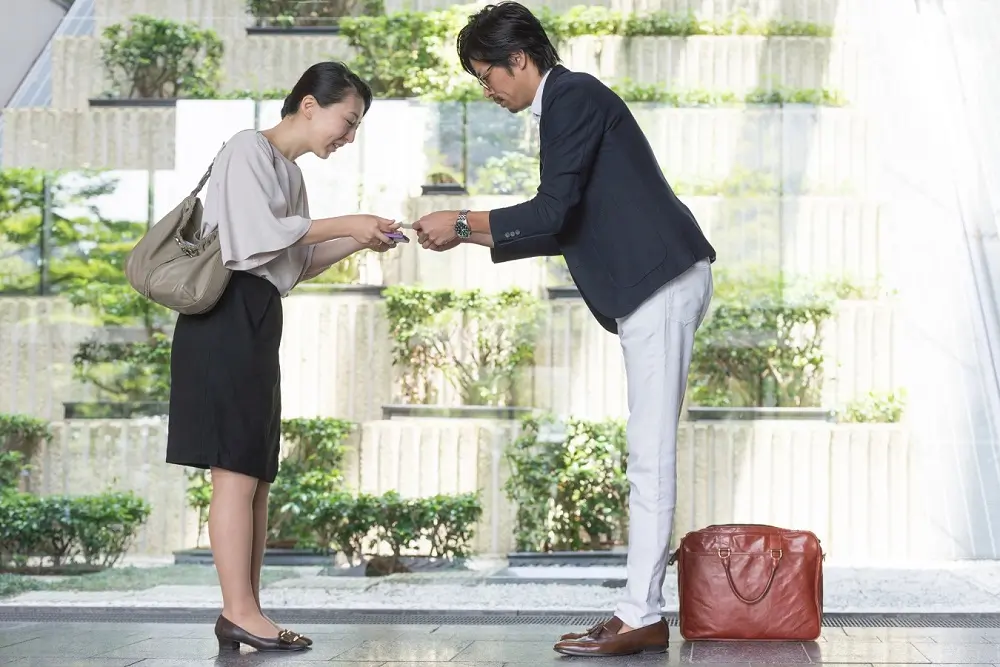Business Cards in Japan: How to Properly Exchange Your Business Card

Business cards, known as meishi (名刺), are fundamental to good business relations and professional etiquette in Japan.
As you may expect, the exchange of business cards, meishi kokan (名刺交換), is a very delicate process with set guidelines that need to be respected. Business cards are significant in Japanese work culture, and Japanese people are very sensitive about your respect for their business cards.
While you’ll likely get a pass as a foreigner, knowing and memorizing the essentials of business card exchanges will still benefit your career in Japan. Read this step-by-step guide on preparing and handing over your own and politely receiving others’ business cards.
1. Make Your Japanese Business Card
Naturally, before commencing business relations, you must order and get your business card printed.
If you work for a company, your employer will arrange for it. If you’re self-employed, however, you’ll need to organize this yourself. To do this, visit a printing company in Japan, and they’ll talk you through styles and designs. You can also order one online and have it sent to you.
Surprisingly, there’s a lot of freedom regarding the designs of business cards in Japan, so don’t hesitate to choose one that suits you. However, ensure it’s easy to read and contains all the necessary information.
The details on the business card include your name, position, company name, company address, telephone number, and email. If your business is multinational, have one side printed in Japanese and another in English.
2. Business Card Holder is Important in Japan
Get yourself a nice business card holder, put several of your business cards inside, and place them in an easy-to-access part of your bag or pocket.
Having your cards difficult to find in your wallet or phone case and fumbling around to find them will make you look unprofessional and ill-prepared. Business card cases are commonly available in Japan; having one will make you look professional.
3. Wait for Your Turn
If you’re in a group, business cards and greetings will be exchanged in order of seniority, so wait your turn and don’t jump ahead. Use this as an opportunity to see how it’s done and prepare yourself for smooth interaction.
Of course, it won’t always be this orderly, and exchanges may sometimes happen more randomly or simultaneously. Just read the room and go with the flow. While this happens, mentally note who is who and their role.
Remembering rank and name is extremely important in Japan, and not addressing the correct person can lead to offense. This probably goes without saying, but you should also be standing during the process.
4. Exchange Your Card
Once your turn arrives, hold your business card around chest level in both hands and present it to the receiver.
Please ensure that the text should be facing in their direction so they can instantly read it, meaning that it should be upside down from your perspective.
Generally, if you are a visitor or of a lower rank, you must present your card first. However, the other party may start before you, so watch their body language for the correct timing. Also, be careful not to cover any logos or names with your fingers.
5. Introduction During Business Card Exchange
While performing the above, bow slightly and state your company name, rank, and name using formal Japanese. This should sound like the following:
“Hajimemashite, [business name] no [rank], [name] to moshimasu.” (初めまして、「会社名」の「肩書」、「名前」と申します。), meaning “Nice to meet you, I am [Your Name], the [Your Title] at [Company’s Name]”
6. Receive Other Person’s Business Card
When receiving the business card, whether it is before or after you’ve given your own, make sure to take it in both hands while saying something like chodai itashimasu (頂戴いたします).
Ensure you don’t cover the name or logo with your fingers. Briefly look at the card with interest and repeat their name and title. It is good to pronounce the name on the card to clarify if you got the pronunciation right. After accepting and reading the card, finish with a “yoroshiku onegaishimasu (よろしくお願いします).”
For more information about what to say, please read the article “Common Japanese Phrases“.
Showing that you read the business card is a sign of respect and will help lead to a productive business relationship.
7. Do Not Put Away the Business Card
After receiving and reading a business card, refrain from putting it away immediately. If you’re taking a seat, place it on the table in front of you and keep it there until the meeting ends.
If you have multiple cards, line them up in front of you as per the seating arrangement of the team you are meeting with. This will make it easier to remember who is who and to show the group respect.
If you’re not sitting down or are planning to go somewhere, place the cards securely in your holder immediately after reading them.
Other things to remember:
- Don’t exchange business cards over a table. Instead, exchange the cards to the other side of the table.
- As mentioned earlier, while offering the business card, hold it towards the top side of the card so that the recipient does not have to rotate it to read it.
- Ensure to maintain eye contact except when reading the received business card.
- Use a clear voice with a respectful yet confident tone.
- Make sure your business cards are clean without any creases.
- Don’t lose someone’s business card. Ensure you have a designated and safe place to store them in your office or at home.
- Generally speaking, the visitor offers the card first
- If the meetings are between teams, higher-ranked individuals exchange the cards first. However, if team sizes are big, you can exchange them simultaneously, too. Just ensure that your side of the senior-most member exchanges the card with the other team’s senior-most person first.
- Refrain from writing on your or anyone else’s business cards.
- If you don’t have a business card, don’t feel embarrassed. Just receive the card of the person you are meeting in the manner explained above and tell them that you’ve run out of cards. In this situation, the following phrase will come in handy: “Tadaima meishi wo kirashite orimashite, moshiwake gozaimasen” (ただいま名刺を切らしておりまして、申し訳ございません), meaning “I apologize, I’m currently out of business cards.”
Conclusion
In conclusion, exchanging business cards in Japan is not just a formality but a pivotal aspect of professional interactions.
Proper exchange of business cards reflects the deep-rooted values of respect, honor, and attention to detail integral to Japanese culture. Understanding and adhering to these Japanese business etiquette rules can open doors to meaningful business relationships and demonstrate your respect for local customs.
The practice of business card exchange in Japan underscores the Japanese emphasis on mutual respect and careful consideration in business dealings, setting the tone for successful and harmonious professional collaborations.
For foreign professionals looking to engage with Japanese counterparts, mastering the art of Meishi Koukan (business card exchange) is more than a skill—it’s a bridge towards building trust and understanding in the complex tapestry of international business.


Born in Melbourne, Australia, Steven came to Japan as an English teacher and currently works as a writer in Niigata City. Bilingual with fluent Japanese language, Steven loves relishing local sake, reading anime, and traveling.

